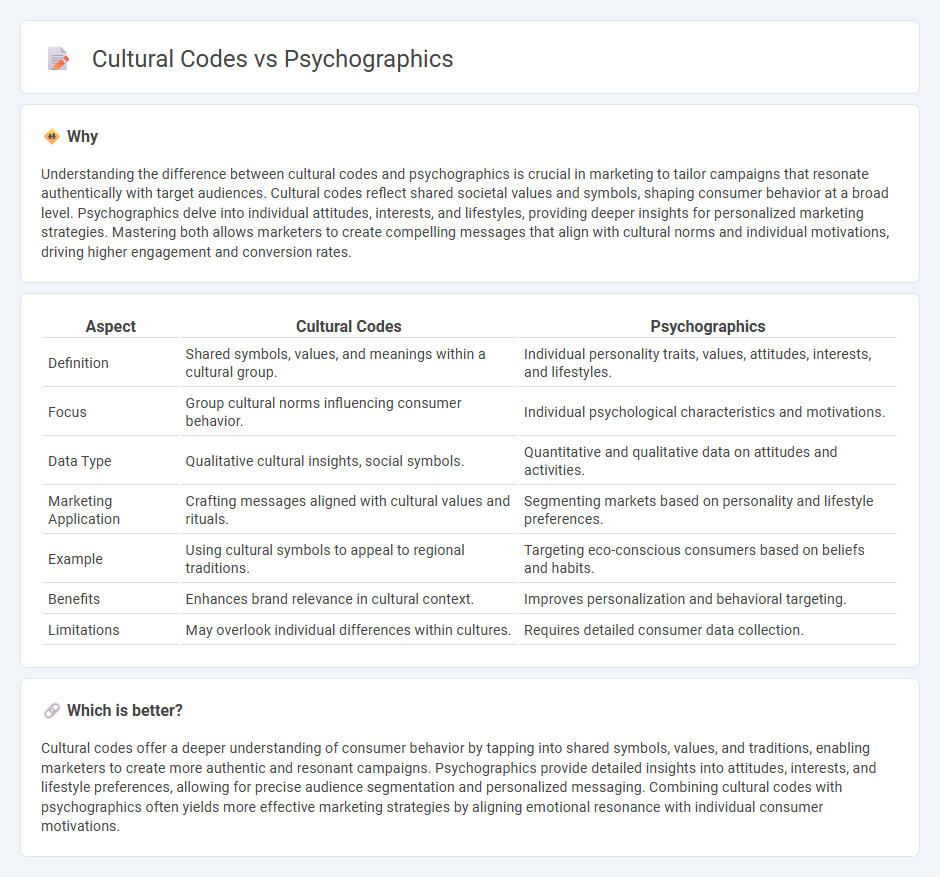
Cultural codes represent the shared symbols, values, and norms that shape consumer behavior within specific social groups, influencing brand perception and purchasing decisions. Psychographics analyze individual lifestyles, interests, attitudes, and personality traits to segment audiences more precisely for targeted marketing campaigns. Explore the nuanced interplay between cultural codes and psychographics to enhance your marketing strategies.
Why it is important
Understanding the difference between cultural codes and psychographics is crucial in marketing to tailor campaigns that resonate authentically with target audiences. Cultural codes reflect shared societal values and symbols, shaping consumer behavior at a broad level. Psychographics delve into individual attitudes, interests, and lifestyles, providing deeper insights for personalized marketing strategies. Mastering both allows marketers to create compelling messages that align with cultural norms and individual motivations, driving higher engagement and conversion rates.
Comparison Table
| Aspect | Cultural Codes | Psychographics |
|---|---|---|
| Definition | Shared symbols, values, and meanings within a cultural group. | Individual personality traits, values, attitudes, interests, and lifestyles. |
| Focus | Group cultural norms influencing consumer behavior. | Individual psychological characteristics and motivations. |
| Data Type | Qualitative cultural insights, social symbols. | Quantitative and qualitative data on attitudes and activities. |
| Marketing Application | Crafting messages aligned with cultural values and rituals. | Segmenting markets based on personality and lifestyle preferences. |
| Example | Using cultural symbols to appeal to regional traditions. | Targeting eco-conscious consumers based on beliefs and habits. |
| Benefits | Enhances brand relevance in cultural context. | Improves personalization and behavioral targeting. |
| Limitations | May overlook individual differences within cultures. | Requires detailed consumer data collection. |
Which is better?
Cultural codes offer a deeper understanding of consumer behavior by tapping into shared symbols, values, and traditions, enabling marketers to create more authentic and resonant campaigns. Psychographics provide detailed insights into attitudes, interests, and lifestyle preferences, allowing for precise audience segmentation and personalized messaging. Combining cultural codes with psychographics often yields more effective marketing strategies by aligning emotional resonance with individual consumer motivations.
Connection
Cultural codes deeply influence psychographics by shaping values, beliefs, and lifestyle preferences that define consumer segments. Psychographics analyze attitudes, interests, and opinions reflecting underlying cultural codes, enabling marketers to tailor messages that resonate authentically. Understanding this connection improves targeted marketing strategies by aligning brand communication with the cultural context of the audience.
Key Terms
Values
Psychographics analyze individual values, attitudes, and lifestyles to predict consumer behavior, while cultural codes represent shared societal values and norms that influence collective identity and communication. Values in psychographics are personalized and vary across demographics, whereas cultural codes reflect broader, ingrained meanings embedded in a community's traditions and symbols. Explore how aligning marketing strategies with both psychographic insights and cultural codes can enhance brand resonance and consumer engagement.
Lifestyles
Lifestyles in psychographics analyze individual behaviors, interests, and values to segment consumers based on daily activities and preferences, resulting in targeted marketing strategies. Cultural codes, however, emphasize shared societal symbols and norms that influence group behavior and collective lifestyle patterns within specific communities. Explore deeper insights on how focusing on lifestyles enhances the effectiveness of psychographics and cultural codes in consumer research.
Symbolism
Psychographics analyze consumer behaviors, values, and lifestyle choices to uncover motivations behind purchasing decisions, while cultural codes encompass shared symbols, rituals, and meanings within a society that shape collective identity and communication. Symbolism plays a crucial role in decoding cultural codes, as it connects brands to deeper societal narratives and emotional resonance beyond individual preferences. Discover how leveraging symbolism bridges psychographics and cultural codes to enhance marketing strategies.
Source and External Links
Psychographics - Wikipedia - Psychographics involves classifying population groups based on psychological variables like personality, values, opinions, attitudes, interests, and lifestyles, commonly used for market segmentation and target marketing.
Psychographics - PR Research - Audience Analysis Resources - Psychographics refers to market research that classifies people by psychological variables such as attitudes, values, and interests, essential for understanding consumer behavior and promoting products effectively.
Psychographics | Definition, Concept & Examples - Psychographic segmentation sorts consumers into groups based on personality traits, values, attitudes, interests, and lifestyle, helping marketers tailor content and identify consumer preferences beyond demographics.
 dowidth.com
dowidth.com